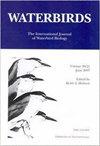蜡烛法和浮法估算水鸟卵胚龄的可比性和可重复性
IF 0.6
4区 生物学
Q3 ORNITHOLOGY
引用次数: 0
摘要
摘要确定胚胎年龄对于预测孵化日期,规划巢访计划以及作为影响巢生存和行为的协变量模型检查因素非常重要。估计胚胎年龄的两种常用方法是卵烛法和卵浮法。尽管依赖于这些方法,但很少有关于这些技术在多个观察者之间的可重复性的信息,或者这些技术是否产生等效的估计。为了确定这些方法的比较,以及每个方法的精度是否受到个人观察者的偏差,成对的观察者点燃并漂浮相同的绒鸭(Somateria mollissima)卵。我们比较了(1)烛化和漂浮孵育期间胚胎年龄估计的差异,(2)成对观察者烛化鸡蛋,(3)成对观察者漂浮鸡蛋。漂浮法和蜡烛法在孵育的某些时期产生了不同的胚胎年龄估计。虽然大多数估计会有几天的偏差,但当方法在项目之间或跨年交换时,不一致性可能会影响结果和统计能力。观察人员对蜡烛法得出了不同的胚胎年龄估计,但对漂浮法却没有,这表明漂浮法可能更可靠。我们的结果表明,当在孵化阶段收集蜡烛和浮动衍生数据时,要谨慎。研究者应该考虑由多个观察者收集的数据如何影响他们的研究问题。本文章由计算机程序翻译,如有差异,请以英文原文为准。
Comparability and Repeatability of Candling and Floating Methods for Estimating Embryo Age of Waterbird Eggs
Abstract. Determining embryo age is important for predicting hatch dates, planning nest visitation schedules, and as a model covariate examining factors affecting nest survival and behavior. Two common methods of estimating embryo age are egg candling and egg flotation (floating). Despite the reliance on these methods, there is little information regarding the repeatability of these techniques between multiple observers, or whether these techniques produce equivalent estimates. To determine how these methods compare and if precision of each method is biased by individual observers, paired observers candled and floated the same Common Eider (Somateria mollissima) eggs. We compared differences in embryo-age estimates across incubation between (1) candling and floating, (2) paired observers candling eggs, and (3) paired observers floating eggs. Floating and candling produced different embryo-age estimates during some periods of incubation. Although most estimates deviated by a few days, inconsistencies could impact results and statistical power when methods are interchanged between projects or across years. Observers derived different embryo-age estimates for candling, but not for floating, suggesting flotation may be more reliable. Our results suggest caution when combining candling and floating-derived data when collected across incubation stages. Investigators should consider how data collected by multiple observers may affect their research question.
求助全文
通过发布文献求助,成功后即可免费获取论文全文。
去求助
来源期刊

Waterbirds
生物-鸟类学
CiteScore
1.30
自引率
0.00%
发文量
0
审稿时长
6-12 weeks
期刊介绍:
Waterbirds is an international scientific journal of the Waterbird Society. The journal is published four times a year (March, June, September and December) and specializes in the biology, abundance, ecology, management and conservation of all waterbird species living in marine, estuarine and freshwater habitats. Waterbirds welcomes submission of scientific articles and notes containing the results of original studies worldwide, unsolicited critical commentary and reviews of appropriate topics.
 求助内容:
求助内容: 应助结果提醒方式:
应助结果提醒方式:


